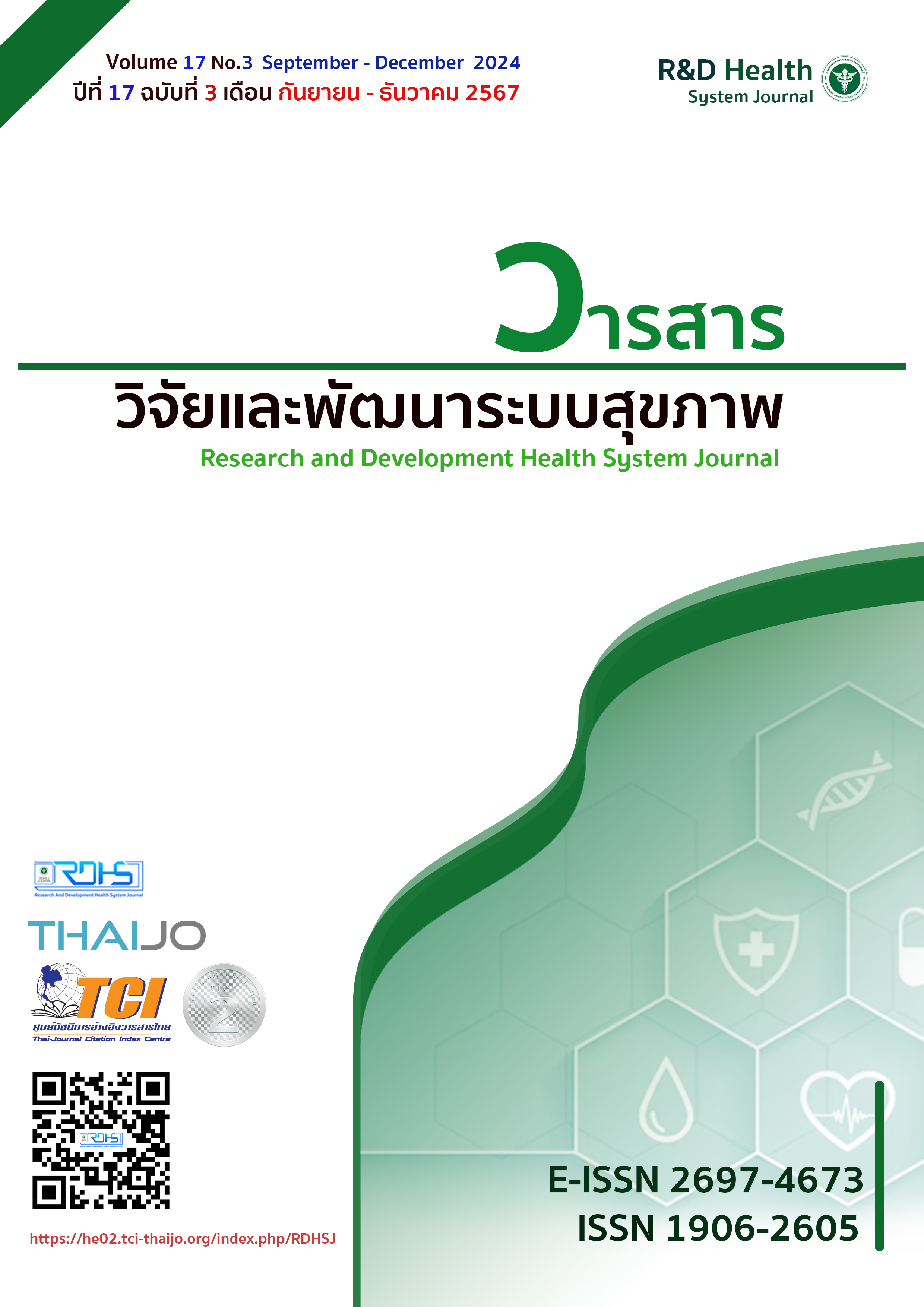การวิเคราะห์บริบทของปัจจัยที่เอื้อและเป็นอุปสรรคต่อการจัดบริการสุขภาพจิต ระดับชุมชน สำหรับผู้ป่วยจิตเวชและยาเสพติดที่มีความเสี่ยงสูงต่อการก่อความรุนแรง: การศึกษาแบบผสานวิธีในหลายระดับ
คำสำคัญ:
การจัดบริการสุขภาพจิต, การวิจัยแบบผสานวิธี, ความรุนแรง, ผู้ป่วยจิตเวชเรื้อรัง, ยาเสพติดบทคัดย่อ
ผู้ป่วยจิตเวชและยาเสพติดที่มีความเสี่ยงสูงต่อการก่อความรุนแรง (Severe Mental Illness with High Risk to Violence: SMI-V) เป็นกลุ่มเปราะบางที่ต้องดูแลสุขภาพจิตอย่างเหมาะสม การจัดบริการสุขภาพจิตระดับชุมชนมีบทบาทสำคัญในการป้องกัน จัดการ และลดความรุนแรง มีวัตถุประสงค์เพื่อศึกษาบริบทวิเคราะห์ปัจจัยที่เอื้อและเป็นอุปสรรคต่อการจัดบริการสุขภาพจิตระดับชุมชน ศึกษาแบบผสานวิธีหลายระดับ วิธีวิจัย 1) การวิจัยเชิงปริมาณวิเคราะห์ข้อมูลทุติยภูมิจากฐานข้อมูล HDC กระทรวงสาธารณสุข ใช้สถิติเชิงพรรณนาและ Fisher's Exact Test การวิเคราะห์ทางสถิติใช้ภาษา R เวอร์ชัน 4.2.1 และแพ็คเกจ tidyverse 2) การวิจัยเชิงคุณภาพสำรวจแบบมีโครงสร้างผ่านแบบสอบถามออนไลน์กับบุคลากรสาธารณสุขในจังหวัดเลย ใช้การวิเคราะห์เนื้อหาและการวิเคราะห์แก่นสาระ
ผลการวิจัย ปี 2566 มีผู้ป่วย SMI-V 6,303 คน (ร้อยละ 1.31) ผู้ป่วยที่มีพฤติกรรมทำร้ายตัวเองและทำร้ายผู้อื่น พบมากที่สุด การวิเคราะห์เชิงคุณภาพแสดงให้เห็นปัจจัยที่เอื้อ เช่น ความร่วมมือของครอบครัวและชุมชน การมีเครือข่ายการทำงานที่เข้มแข็ง และนโยบายที่เอื้อต่อการดูแล ปัจจัยที่เป็นอุปสรรค ได้แก่ ทัศนคติเชิงลบ การขาดแคลนบุคลากร และงบประมาณที่ไม่เพียงพอ
การจัดบริการสุขภาพจิตระดับชุมชนสำหรับผู้ป่วย SMI-V การพัฒนาระบบบริการที่มีประสิทธิภาพต้องอาศัยความร่วมมือระหว่างหน่วยงาน การเสริมสร้างศักยภาพของบุคลากร การจัดสรรงบประมาณอย่างเหมาะสม และการสร้างความตระหนักรู้ในชุมชน
Downloads
เอกสารอ้างอิง
Metrics IoH, Evaluation. Global health data exchange (GHDx). 2021.
Thai PBS. เร่งผลิต จิตแพทย์ รับมือสถานการณ์โรคจิตเวช 2567 [อินเตอร์เน็ต]. เข้าถึงได้จาก: https://policywatch.thaipbs.or.th/article/life-27.
DeAngelis T. Mental illness and violence: Debunking myths, addressing realities. American Psychological Association; 2022.
Dinn WM, Gansler DA, Moczynski N, Fulwiler C. Brain dysfunction and community violence in patients with major mental illness. Criminal Justice and Behavior 2009; 36(2): 117-36.
Van Dorn R, Volavka J, Johnson N. Mental disorder and violence: is there a relationship beyond substance use? Social psychiatry and psychiatric epidemiology 2012; 47: 487-503.
Swartz MS, Swanson JW, Hiday VA, Borum R, Wagner HR, Burns BJ. Violence and severe mental illness: the effects of substance abuse and nonadherence to medication. American journal of psychiatry 1998; 155(2): 226-31.
Bradizza CM, Stasiewicz PR. Qualitative analysis of high-risk drug and alcohol use situations among severely mentally ill substance abusers. Addictive Behaviors 2003; 28(1): 157-69.
กรมสุขภาพจิต กระทรวงสาธารณสุข. มาตรฐานการปฏิบัติงานการดูแลผู้ป่วยจิตเวชและยาเสพติดที่มีความเสี่ยงสูงต่อการก่อความรุนแรง Severe Mental Illness – High Risk to Violence (V-Care). คลังความรู้สุขภาพจิต กรมสุขภาพจิต, editor. กรุงเทพ: บริษัท บียอนด์พับลิสชิ่ง จำกัด; 2024: 48
R Core Team. RA language and environment for statistical computing, R Foundation for Statistical. Computing; 2020.
Wickham H, Averick M, Bryan J, Chang W, McGowan LDA, François R, et al. Welcome to the Tidyverse. Journal of open source software 2019; 4(43): 1686.
ระบบคลังข้อมูลด้านการแพทย์และสุขภาพ กระทรวงสาธารณสุข (HDC). ฐานข้อมูลผู้ป่วย SIM-V ระบบคลังข้อมูลด้านการแพทย์และสุขภาพ; 2023.
กรมสุขภาพจิต กระทรวงสาธารณสุข. รายงานข้อมูลผู้ป่วย SIM-V โรงพยาบาลจิตเวช 14 แห่ง (Internal report): unpublished. Unpublished; 2024.
Mauri MC, Cirnigliaro G, Piccoli E, Vismara M, De Carlo V, Girone N, et al. Substance abuse associated with aggressive/violent behaviors in psychiatric outpatients and related psychotropic prescription. International Journal of Mental Health and Addiction. 2023; 21(6): 4071-84.
Bronfenbrenner U. Ecological systems theory: American Psychological Association; 2000.
Brüchert T, Quentin P, Baumgart S, Bolte G. Barriers, facilitating factors, and intersectoral collaboration for promoting active mobility for healthy aging—a qualitative study within local government in Germany. International journal of environmental research and public health 2021; 18(7): 3807.
World Health Organization. Guidance on community mental health services: promoting person-centred and rights-based approaches: World Health Organization; 2021.
UNODC. Guidance for Community-Based Treatment and Care Services for People Affected by Drug Use and Dependence in Southeast Asia [Internet]. Thailand: UNODC; 2014 [cited 2024 Oct 24]. Available from: http://www.unodc.org/documents/southeastasiaandpacific/
cbtx/cbtx_ guidance_EN.pdf
ดาวน์โหลด
เผยแพร่แล้ว
รูปแบบการอ้างอิง
ฉบับ
ประเภทบทความ
สัญญาอนุญาต
ลิขสิทธิ์ (c) 2024 สำนักงานสาธารณสุขจังหวัดกาฬสินธุ์

อนุญาตภายใต้เงื่อนไข Creative Commons Attribution-NonCommercial-NoDerivatives 4.0 International License.
เนื้อหาและข้อมูลในบทความที่ลงตีพิมพ์ในวารสารศูนย์ดัชนีการอ้างอิงวารสารไทย ถือเป็นข้อคิดเห็นและความรับผิดชอบของผู้เขียนบทความโดยตรงซึ่งกองบรรณาธิการวารสาร ไม่จำเป็นต้องเห็นด้วย หรือร่วมรับผิดชอบใด ๆบทความ ข้อมูล เนื้อหา รูปภาพ ฯลฯ ที่ได้รับการตีพิมพ์ในวารสารศูนย์ดัชนีการอ้างอิงวารสารไทย ถือเป็นลิขสิทธิ์ของวารสารศูนย์ดัชนีการอ้างอิงวารสารไทย หากบุคคลหรือหน่วยงานใดต้องการนำทั้งหมดหรือส่วนหนึ่งส่วนใดไปเผยแพร่ต่อหรือเพื่อกระทำการใด จะต้องได้รับอนุญาตเป็นลายลักณอักษรจากวารสารศูนย์ดัชนีการอ้างอิงวารสารไทยก่อนเท่านั้น







